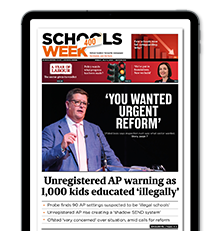The attainment gap between disadvantaged primary school pupils and their better-off peers has narrowed again this year – but it is still above pre-pandemic levels.
The Department for Education’s provisional key stage 2 SATs results show a disadvantage gap index of 3.12, down from 3.21 last year.
It’s dropped from the 3.23 in 2021-22 – the widest gap in 10 years.
But it is still wider than the 2.91 gap in pre-pandemic 2018-19. This year’s figures are similar to where the gap stood 10 years ago (3.10 in 2014-15 and 3.15 in 2013-14).
‘More must be done’
Paul Whiteman, general secretary at NAHT school leaders’ union, said these “disparities have been impacted by the pandemic, cost-of-living crisis, and a decade of cuts to school funding and community support”.
“When families are struggling with insecure housing, and facing impossible budgeting decisions around eating and heating, this inevitably affects children’s ability to attend school and focus and thrive in class.
“This isn’t just an issue for education, and while welcome, the government’s promise to tackle child poverty must deliver tangible results, and more must also be done to ensure social care and mental health services are equipped to support children and families facing challenges.”

Children who did their SATs this year were in year two when the country first locked down.
Results data published last term showed the proportion of pupils meeting the government’s “expected standard” in reading, writing and maths SATs rose slightly this year. But it was still not back to pre-pandemic levels.
Today’s figures show 45 per cent of disadvantaged pupils reached this standard, compared to 67 per cent of their peers, a one percentage point rise for both groups of pupils.
In 2018-19, 51 per cent of disadvantaged pupils met the standard.
For pupils with special educational needs, 21 per cent achieved the standard, up from 20 per cent last year. But it is still below the 22 per cent seen in 2018-19.
Gender gap remains static
The gender gap between boys and girls remains static at seven percentage points, with 64 per cent of girls reaching the standard compared to 57 per cent of boys.
The biggest gap between boys and girls remains in the writing teacher assessment, at 13 percentage points. Boys performed slightly better in maths.
When looking at ethnicity, Chinese pupils were the highest performing group – 74 per cent of pupils met the “expected standard” – whereas Gypsy/Roma pupils were the lowest performing at 18 per cent.
Children were more likely to reach the expected standard in reading, writing and maths if they attended a free school (68 per cent) or converter academy (63 per cent) than if they attended a local authority-maintained school (61 per cent) or sponsored academy (58 per cent).
Attainment also varies hugely by local authority area. The gap between the highest (London) and the lowest (south west) performing regions remains at 10 percentage points.
In Portsmouth and the Isle of Wight, just 51 per cent of pupils met the standard, compared to 75 per cent in Richmond upon Thames and 74 per cent in Hammersmith and Fulham.
Phillipson warns of poverty ‘challenge’
Bridget Phillipson, the education secretary, warned today that the data showed “around a third of children leaving primary school do not meet the expected standard in reading, writing and maths following assessment.
“There are pockets across our country where only every other child is leaving primary school meeting the expected standard in reading, writing and maths.

“Lurking beneath all of these separate challenges is a common denominator of distress: child poverty – the stain on our society that has seeped into the fabric of far too many families.”
In a speech to a Sutton Trust event launching today’s OECD education-at-a-glance report, she said Labour planned to broaden the curriculum while “never compromising on standards in the basics”.
“Those standards must be for each and every child. When they slip, it’s not middle-class parents who miss out – they can pay for tutors to pick up the slack. It’s the children without support at home who fall further behind.”
















The piece does a good job highlighting the progress made in narrowing the disadvantage gap, and it’s encouraging to see some positive movement despite the challenges. However, I’m curious about the strategies being considered to further close the gap and support disadvantaged students more effectively? It seems like the task will require collective effort beyond just educational policies and might need more community involvement.
The article also touched upon different factors affecting this disparity, such as housing and social issues. It’d be interesting to explore more on how these external factors are being integrated into educational support strategies. Overall, a thought-provoking read!